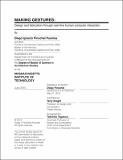| dc.contributor.advisor | Terry Knight. | en_US |
| dc.contributor.author | Pinochet Puentes, Diego Ignacio | en_US |
| dc.contributor.other | Massachusetts Institute of Technology. Department of Architecture. | en_US |
| dc.date.accessioned | 2015-10-14T14:35:40Z | |
| dc.date.available | 2015-10-14T14:35:40Z | |
| dc.date.copyright | 2015 | en_US |
| dc.date.issued | 2015 | en_US |
| dc.identifier.uri | http://hdl.handle.net/1721.1/99252 | |
| dc.description | Thesis: S.M., Massachusetts Institute of Technology, Department of Architecture, 2015. | en_US |
| dc.description | This electronic version was submitted by the student author. The certified thesis is available in the Institute Archives and Special Collections. | en_US |
| dc.description | Cataloged from student-submitted PDF version of thesis. | en_US |
| dc.description | Includes bibliographical references (pages 106-107). | en_US |
| dc.description.abstract | Design is "something that we do" that is related to our unique human condition as creative individuals, so as "making" is related to how we manifest and impress that uniqueness into our surrounding environment. Nonetheless, the use of technology in architectural design, by being focused mainly on the representation -both digital and physical - of a pre-determined idea, has neglected using digital tools in a more exploratory way by integrating body and senses in the design processes. As physical modeling, gestures, and tools are mechanisms by which designers learn and think, I assert that creativity emerges in the very moment of impression of the self onto the material world as an improvised choreography between humans and objects -materials and tools- by using body gestures neither as action nor perception, but as the unity of both. If we are to extend our creativity and enhance the design experience through the use of digital tools, we need to reformulate the way we interact with computers and fabrication machines, by developing new models and strategies focused on the integration between both. In this thesis, I propose an alternative way for designers to use digital tools, transcending from a model of 'operation' to a model of 'interaction'. My hypothesis is that real-time interaction between designers and fabrication machines can augment our creativity and cognition engaging exploration, speculation and improvisation of designs through the use of gestures and interactive computation. I propose a model of interaction that seeks to transcend the 'hylomorphic' model imperative in today's architectural design practice to a more reciprocal form of computational making. To do so, I propose the Making Gestures project, which explores real-time interaction between mind, body, and tools by using body gestures and imbuing fabrication machines with behavior in order to establish a dialog, which embraces ambiguity and the unexpected to engage the designer into insightful design processes. | en_US |
| dc.description.statementofresponsibility | by Diego Ignacio Pinochet Puentes. | en_US |
| dc.format.extent | 115 pages | en_US |
| dc.language.iso | eng | en_US |
| dc.publisher | Massachusetts Institute of Technology | en_US |
| dc.rights | M.I.T. theses are protected by copyright. They may be viewed from this source for any purpose, but reproduction or distribution in any format is prohibited without written permission. See provided URL for inquiries about permission. | en_US |
| dc.rights.uri | http://dspace.mit.edu/handle/1721.1/7582 | en_US |
| dc.subject | Architecture. | en_US |
| dc.title | Making gestures : design and fabrication through real time human computer interaction | en_US |
| dc.title.alternative | Design and fabrication through real time human computer interaction | en_US |
| dc.type | Thesis | en_US |
| dc.description.degree | S.M. | en_US |
| dc.contributor.department | Massachusetts Institute of Technology. Department of Architecture | |
| dc.identifier.oclc | 922927563 | en_US |
